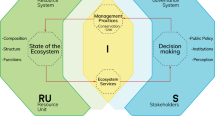Abstract
Characterized by their openness, complexity and large scale, forest ecosystems interweave themselves with social system, economic system and other natural ecosystems, thus complicating both their researches and management decision-making. According to the theories of sustainable development, hierarchy-competence levels, cybernetics and feedback, 25 factors have been chosen from human society, economy and nature that affect forest ecosystem management so that they are systematically analyzed via developing an interpretive structural model (ISM) to reveal their relationships and positions in the forest ecosystem management. The ISM consists of 7 layers with the 3 objectives for ecosystem management being the top layer (the seventh layer). The ratio between agricultural production value and industrial production value as the bases of management decision-making in forest ecosystems becomes the first layer at the bottom because it has great impacts on the values of society and the development trends of forestry, while the factors of climatic environments, intensive management extent, management measures, input-output ratio as well as landscape and productivity are arranged from the second to sixth layers respectively.
Access this chapter
Tax calculation will be finalised at checkout
Purchases are for personal use only
Preview
Unable to display preview. Download preview PDF.
Similar content being viewed by others
References
Franklin, J.: The New Forestry. Journal of Soil and Water Conservation 44, 549 (1989a)
Franklin, J.: Toward a New Forestry. American Forests 6, 69–74 (1989b)
Franklin, J.: Thoughts on Applications of Silvicultural Systems under New Forestry. Forest Watch 10(7), 8–11 (1990)
Thomas, J.W.: FEMAT: Objective, Process, and Options. Journal of Forestry 92(4), 66–70 (1994)
Xu, D.Y., Zhang, X.Q.: Forest Ecosystem Management — the Focus of the 21st Century (in Chinese, with English abstract). World Forestry Research 2, 1–7 (1998)
Xu, G.Z.: Promote the Development of Forest Management by Attach More Importance to the Study on the Complexity of System and Management (in Chinese, with English abstract). Forest Inventory and Planning 4, 1–4 (2002)
Chen, X.L.: Structure Exploration of Forest Ecosystem Management (in Chinese, with English abstract). J. of Central South Forestry University 19(2), 43–47 (1999)
Xu, G.Z.: Ecological Problems and Forest Ecosystem Management (in Chinese, with English abstract). Central South Forest Inventory and Planning 23(1), 1–5 (2004)
Warfield, J.N.: Binary Matrices in System Modeling. IEEE Transactions on Systems, Man, and Cybernetics 3(5), 441–449 (1973)
Warfield., J.N.: Structuring Complex Systems. Battelle Memorial Institute Monograph, Columbus, Ohio, vol. 4 (1974a)
Warfield, J.N.: Developing Subsystem Matrices in Structural Modeling. IEEE Transactions on Systems, Man, and Cybernetics 4(1), 74–80 (1974b)
Warfield, J.N.: Toward Interpretation of Complex Structural Models. IEEE Transactions on Systems, Man, and Cybernetics 4(5), 405–417 (1974c)
Warfield, J.N.: Implication Structures for Systems Interconnection Matrices. IEEE Transactions on Systems, Man, and Cybernetics 6(1), 18–24 (1976)
Kenneth, L.R.: Structural Examination of Identity in an Individual with Severe Physical Disabilities. Journal of Developmental and Physical Disabilities 9(2), 91–100 (1997)
Aber, J.D., Melillo, J.M., Mcclaugherty, C.A.: Predicting Long-Term Patterns of Mass Loss, Nitrogen Dynamics and Soil Organic Matter Formation from Initial Fine Litter Chemistry in Temperate Forest Ecosystems. Canadian Journal of Botany 68, 2201–2208 (1990)
Frangi, J.L., Lugu, A.E.: Biomass and Nutrient Accumulation in Ten Year Old Bryophyte Communities Inside a Flood Plain in the Luquillo Experimental Forest, Puerto Rica. Biotropica 24, 106–112 (1992)
Leone, A., Marini, R.: Assessment and Mitigation of the Effects of Land Use in a Lake Basin (Lake Vicoin in Central Italy). Journal of Environmental Management 39, 39–50 (1993)
Pu, Y.S., Zhang, Z.Y., Pu, L.N., Hui, C.M.: Biodiversity and Its Fragility in Yunnan, China. Journal of Forestry Research 18(1), 39–47 (2007a)
Pu, Y.S., Zhang, Z.Y., Pu, L.N.: Strategic Studies on the Biodiversity Sustainability in Yunnan Province, Southwest China. Forestry Studies in China 9(3), 225–237 (2007b)
Laudon, K.C., Laudon, J.P.: Management Information Systems: New Approaches to Organization and Technology. Prentice Hall, Upper Saddle River (1998)
Wilson, J.B., Agnew, A.D.Q.: Positive Feedback Switches in Plant Communities. Advances in Ecological Research 23, 263–336 (1992)
Christine, F., Harald, V., Carsten, L., Franz, M., Vilem, P., Vladimir, J.: Meeting the Challenges of Process-Oriented Forest Management. Forest Ecology and Management 248(1-2), 1–5 (2007)
Andrew, P.S.: System Engineering: Methodology & Application. IEEE Press, Los Alamitos (1977)
Richard, H.W.: Interpretive Structural Modeling — a Useful Tool for Technology Assessment. Techn. Fcst. Soc. Chg. (2), 165–185 (1978)
Watson, R.H.: Interpretative Structural Modeling — a Useful Tool for Technology Assessment. Technological Forecasting and Social Change 11(2), 165–185 (1978)
Costanza, R.: The Value of the World’s Ecosystem Services and Natural Capital. Nature 387, 253–256 (1997)
Frederick, C., Patrice, H., Erin, S.: Policy Instruments to Enhance Multi-functional Forest Management. Forest Policy and Economics 9(7), 833–851 (2007)
Daniel, W.M., John, H.P.: Spatial Models of Site Index Based on Climate and Soil Properties for Two Boreal Tree Species in Ontario. Forest Ecology and Management 175(1-3), 497–507 (2003)
Author information
Authors and Affiliations
Editor information
Editors and Affiliations
Rights and permissions
Copyright information
© 2009 ICST Institute for Computer Science, Social Informatics and Telecommunications Engineering
About this paper
Cite this paper
Liu, S. et al. (2009). Studies on Interpretive Structural Model for Forest Ecosystem Management Decision-Making. In: Zhou, J. (eds) Complex Sciences. Complex 2009. Lecture Notes of the Institute for Computer Sciences, Social Informatics and Telecommunications Engineering, vol 4. Springer, Berlin, Heidelberg. https://doi.org/10.1007/978-3-642-02466-5_94
Download citation
DOI: https://doi.org/10.1007/978-3-642-02466-5_94
Publisher Name: Springer, Berlin, Heidelberg
Print ISBN: 978-3-642-02465-8
Online ISBN: 978-3-642-02466-5
eBook Packages: Computer ScienceComputer Science (R0)




